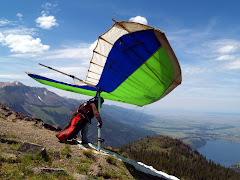 For the past couple of years, Ken Hawes and I and our sweeties have made it an annual event to drive down to Burney, California to partake in the yearly Hat Creek Rim Fly-in held over Labor Day weekend. This year will be no exception.
For the past couple of years, Ken Hawes and I and our sweeties have made it an annual event to drive down to Burney, California to partake in the yearly Hat Creek Rim Fly-in held over Labor Day weekend. This year will be no exception.I can't recall exactly how or when I first crossed paths with the friendly folks who put on and participate in this event, but since that time we've made it a point to stay in touch. As a result, we've done our best to attend the others' events and support our respective home sites.
Hat Creek Rim is one of those magic places noted for its beauty as viewed from both the air and the ground. It's situated just down the road from the town of Burney, CA between the (currently) extinct volcanoes Mt. Shasta and Mt. Lassen. While the rim is noted for its amazing glass-0ff conditions, many cross-country flights into the northern California desert have started here. There's also a great campground nearby that fills with both pilots and fishermen, particularly over Labor Day weekend.
What really makes flying here fun though is the people. When Ken & I first attended the Labor Day fly-in, we were immediately greeted with open arms as 'the winged brethren to the north'. These folks love to fly and celebrate life, and they really know how to put on a fly-in. Nowhere else have I landed to the sound of such loud applause! It's enough to make your helmet too tight! There is also a talented Bluegrass band that performs each night of the weekend at the campground. Eventually, the crew ends up sitting around the campfire swapping stories (about hang gliding, of course), bad jokes, and other silly conversation. Of course, eventually someone starts making little paper helicopters to be launched over the flames, and there's an informal contest to see who can fly theirs highest and farthest.
The ladies seem to really enjoy this little get-together too. They put up with a lot from us the rest of the year, chasing us around the countryside to collect us and our gear after landing out, but they really seem to enjoy this event, no doubt because of the people. The flying here is incredible, but a nice flight is just the icing on the cake for us pilots.












